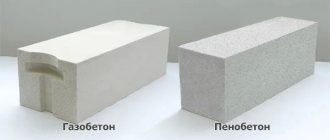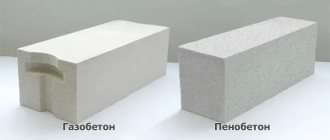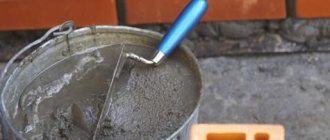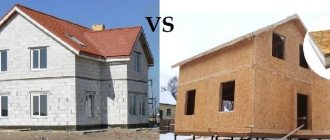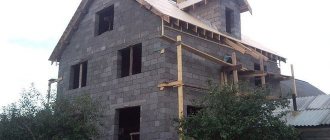Marketers often mislead unprepared people by creating myths about building materials.
If most people have a very clear idea about concrete or brick, then light types of concrete are most often unfamiliar to the mass user. This is not surprising - in Soviet times, construction was carried out from dense materials, and modern private housing construction is distinguished by a wide variety of options. Some types of lightweight concrete are even considered exotic samples, although they have been known for a long time. Such materials are wood concrete and aerated concrete, which are well known to specialists, but little known to ordinary users. Situations often arise when you need to make a choice between them. Wood concrete or aerated concrete, which is better, is a question that requires a careful study of the properties and features of these materials.
What is aerated concrete
Aerated concrete is a building material from the cellular concrete family. It was developed almost 100 years ago, but debate about its suitability for serious construction is still ongoing. The reason for this is the specific structure of the material, which differs sharply from traditional types of concrete. The aerated concrete mass contains many gas cavities ranging in size from 2 to 4 mm, thanks to which the material becomes light and acquires the properties of a heat insulator. However, the presence of pores makes the material loose and brittle, unable to withstand heavy loads. Because of this, many builders do not perceive aerated concrete as a serious building material. In addition, a lot of controversy is caused by the need to protect walls made of aerated blocks from rain and atmospheric moisture. However, the relatively low cost of the material and the ease of working with it have made the material in demand and widely used in private housing construction. There are no excess loads here, since the height of a private house rarely exceeds 2 floors (the standard limit for the most popular aerated concrete D500 is 3 floors).
Advantages and disadvantages of aerated concrete
The advantages of aerated concrete include:
- the light weight of the material reduces the load on the foundation and makes construction more convenient;
- low thermal conductivity allows you to save on heating;
- the smooth surface of the blocks ensures precise fit during thin-seam installation;
- aerated concrete is easy to process, which facilitates the alignment of rows and the production of additional blocks.
Disadvantages of aerated concrete:
- the inability to withstand heavy loads forces the use of special techniques during construction;
- the hygroscopicity of the material requires protection from moisture;
- it is necessary to ensure normal removal of water vapor from external walls;
- the material shrinks; after construction is completed, the house has to be kept for 6-18 months to dry and load.
There are no less disadvantages than advantages. This causes a lot of controversy and does not allow us to clearly call aerated concrete or wood concrete the best material.
Useful video
This sales manager throws both blocks and thus tries to show the advantages of wood concrete. It's like throwing a wooden beam and a brick and concluding that a house made of wood is better than a brick one. For the reason that the brick will crack. The comparison should be made based on all characteristics, as demonstrated in our article. Don't fall for these kinds of advertising gimmicks.
We tried to write the best article. If you liked it, please share it with your friends or leave a comment below. Thank you! Great article 7
Manufacturing process
The production of aerated concrete is a complex technological process that takes place in several stages. Composition of raw materials:
- Portland cement;
- quarry quartz sand;
- lime;
- water;
- aluminum powder (usually it is used in the form of a paste so that the material does not scatter throughout the workshop),
The manufacturing process is as follows:
- The components are crushed in industrial crushers and fed into a common container using dispensers. They are mixed, water is added, and a chemical reaction of lime and aluminum powder begins in the presence of water.
- To ripen, the mixture is placed in a special form, where it swells like yeast dough. The process lasts about 12 hours (sometimes more, depending on the ratio of components).
- At the end of the reaction, the material is removed from the mold and sent to the slicing department. Using special strings and cutters, gas blocks of even and precise geometric shapes are cut out.
- After this, the material is sent for final ripening in the presence of superheated steam. The process lasts about a day, after which the material is sent for drying and to the distribution network.
The process of manufacturing non-autoclaved aerated concrete, which appeared earlier and has been used for about 100 years, is described. Modern technology has changed somewhat - at the finishing stage, cut gas blocks are placed in an autoclave and treated with hot steam under high pressure. Autoclaved aerated concrete is stronger and harder, which allows it to be used for the construction of private houses up to 3 floors high (or more if high-density material is produced).
Main characteristics of the foam block
Foam concrete is an equally common type of lightweight concrete that is easier to work with and transport than regular brick. Foam concrete is divided into synthetic and natural (depending on the materials used in production). To make foam concrete, as a rule, cement, a mixture of sand and a foaming agent are used.
Foam concrete is a material for construction in regions with high humidity, as it does not absorb moisture from the ground and atmosphere.
When using this material, there is no need to spend huge amounts of money on waterproofing and finishing.
Important! When transporting foam concrete, it is important to take into account the high fragility of this material. If transported carelessly, the blocks may crack. Arbolite does not suffer from such a drawback.
Brands and strength classes of aerated concrete
Aerated concrete is produced in different density options, adjusting the ratio of the mass and gas cavities. the material is divided into strength classes and density grades. The strength class determines the ability to withstand pressure. It is designated by the Latin letter B and numbers that determine the maximum permissible load. For example, B2.5 means that the material can withstand a load of up to 2.5 Newtons per square millimeter (in other words, 25 kg/mm2). They produce aerated blocks with strength from B0.75 to B20, but the most popular are blocks with values up to B3.5.
The grade of aerated concrete is an indicator of the ratio of the mass and air cavities, that is, density. They are designated by the Latin letter D and numbers indicating the density of the material. For example, the most popular D500 gas block has a density of 500 kg/m3. It is necessary to take into account that this value is conditional; the actual weight is usually slightly higher.
Classes and brands are interconnected - as the brand increases, the class increases. In trade, brand indicators are most often used, since it is believed that they give the user more information about the properties of the material.
There are three categories of aerated concrete:
- thermal insulation, includes grades D250-D350;
- structural and thermal insulation (D400-D600);
- structural (D700 and higher).
As the name suggests, heat-insulating material is used for insulating or assembling internal partitions. The second group is the most popular; private houses are built from it (the most in demand is aerated concrete of the D500 brand). Structural aerated concrete is used for the construction of apartment buildings or industrial buildings. It is denser and heavier, therefore, it is not in demand in private housing construction.
What is wood concrete
Wood concrete is a building material, the main components of which are wood chips and cement. It was used during the Soviet era, but in the 90s many more modern building materials appeared. They became fashionable, and wood concrete was almost forgotten, although its properties make it possible to use the material for the construction of residential or office premises 2-3 floors high. At the same time, many builders considered it only a heat insulator, an additional material that had no independent value. However, the technical characteristics of wood concrete are very close to those of aerated concrete, which often forces developers to think about what to choose, aerated concrete or aerated concrete.
The material is produced in the form of blocks measuring 500 × 300 × 200 mm (there are options 600 × 300 × 200 or the northern version 410 × 300 × 200 mm). The blocks have an even geometry, although their surface cannot be called smooth. This forces you to make thicker seams when laying, which increases the risk of cold bridges.
The composition of wood concrete is unusual and for many builders it is very strange. At the same time, in the 60s of the last century, many premises for housing or office needs were built from wood concrete. The main reason for the temporary disappearance of the material is the lack of mass production technologies. However, today lines have been created and manufacturing methods have been developed that have radically changed the attitude of builders to wood concrete.
Comparison with gas silicate
Aerated concrete differs from aerated silicates in the binder used in its production: lime, not Portland cement. This leads to slightly different qualities, but, in general, the materials are very similar to these.
Gas silicate is produced only by autoclave method. Compared to aerated concrete based on Portland cement, its strength indicators are higher, but as a heat insulator the material is worse, and is also even more hygroscopic.
Advantages and disadvantages of wood concrete
Supporters of wood concrete claim that it combines all the positive properties of most known building materials. However, in reality, wood concrete has both advantages and disadvantages. The positive qualities of the material include:
- resistance to bending loads. Arbolite has some elasticity and does not crack when bending influences occur;
- low thermal conductivity, ability to retain thermal energy;
- wood concrete has the ability to dampen noise;
- despite the large presence in wood chips (up to 90%), the material belongs to the category of low-flammability;
- light weight. The material does not create a load on the base and is very convenient in construction;
- ease of processing;
- Wood concrete does not rot and has high air permeability, ensuring active removal of water vapor.
Disadvantages of wood concrete:
- hygroscopicity, unsuitable for use in damp areas;
- the material does not tolerate exposure to aggressive gases;
- the need to protect walls from contact with water, remove the cornice and cut off the base;
- non-ideal geometry of piece elements (the range of linear dimensions can be from 0.5 to 1.5 cm).
It should be noted that the advantages and disadvantages of the material are very similar to those of aerated concrete. Sometimes this makes it difficult to make a decision - choosing wood concrete or aerated concrete for building a house, guided only by the pros and cons, is too difficult.
Manufacturing process
In Soviet times, wood concrete was made in different ways. There were no strict standards regarding the composition of the material (they were developed only in 2011, when GOST R 54854-2011 appeared, which defined types of material and established requirements for their composition).
In the production of wood concrete, the main component is wood chips, which makes up 80-90% of the total volume. The remaining 10-20% consists of a cement binder and special additives for pore formation and mineralization of wood.
Instead of wood chips, plant fire (waste from processing) or rice straw can be used. However, wood concrete is the most popular and in demand. In addition, chemical additives are required, which may include:
- calcium chloride;
- liquid glass;
- lime;
- alumina sulfate, etc.
The purpose of these components is to accelerate the hardening of the material during manufacturing and protect the reinforcement from corrosion. In addition, additives bind sugars in wood, which provides protection against rotting. There is another type of additive - pore formers. They are needed to organize the removal of moisture from the material.
Many technological methods are used, from manual molding to placement in molds and vibration compaction on special stands. The material can be made in artisanal conditions, which increases its presence on the market, but complicates the selection of quality blocks.
There is another construction technology using wood concrete, when raw materials (cement paste, as experts call it) are poured into formwork and monolithic finished structures are obtained - walls, piers or other structural elements. They require a supporting frame, but the overall progress of construction is significantly accelerated.
Which material to choose?
The parameters of wood concrete and aerated concrete are largely the same, or have a slight difference. The final choice - wood concrete or gas block - is the prerogative of the developer, although some recommendations can be given in this matter.
Arbolite has some elasticity. Therefore, it can be used in conditions of heaving soils prone to seasonal movements. Aerated concrete cracks under such conditions, which jeopardizes the condition of the structures.
The cost of the material is an important factor that sometimes determines the choice. All other things being equal, they consider the price and determine what is more expensive, aerated concrete block or wood concrete. It is noteworthy that in different regions the cost of materials differs; in some places aerated concrete is more expensive, in others it is wood concrete.
In addition, the personal opinions of developers are also taken into account. There is no fundamental difference between the materials; their parameters and performance qualities differ little from each other. Therefore, you can be guided by other considerations and make a choice based on your own preferences.
Arbolite blocks
Specifications
“Wooden blocks” are used in construction in any climatic zone of the country due to their exceptional properties:
- State standard. Wood concrete was first learned about during the Soviet Union, and standards were approved in 1983. According to the standards, the material does not require additional insulation, since upon release a finishing layer is prepared that retains moisture. There are two types of wood concrete based on thermal insulation characteristics: structural, used in the construction of external walls; thermal insulation, used for internal partitions.
- Weight. Lightweight building material does not require the installation of a reinforced foundation.
- Size. According to the parameters, four groups are distinguished: wide (500*250*300 mm); medium (500*250*200 mm); narrow (500*250*150 mm); connecting (1500*250*300 mm).
- Thermal conductivity. High heat capacity is an excellent property of wood concrete. The temperature inside a room made of such material is always comfortable. The substance easily absorbs heat and moisture and releases them easily.
- Strength. There is no definitive answer to the durability of the material. Treating the walls with a primer and covering them with natural stone will help extend the service life. The material is characterized by elasticity and cracks do not appear on it. Recently, the addition of latex to the composition further increases strength.
- Environmentally friendly. Builders have differing opinions on the issue of harmfulness, but experts say that the durable material is ideal for those who care about their health. It becomes harmful only if the manufacturing technology is violated.
- Frost resistance. The blocks can withstand low temperatures and can withstand freezing and defrosting, but in the absence of moisture.
- Fire safety. Although the composition includes wood elements, the material does not support combustion. There is no need to use special fireproof protection.
Return to contentReturn to content
Advantages
For comparison, we highlight a number of advantages:
- pressure resistance, alignment to the original shape;
- low thermal conductivity;
- does not require additional reinforcement or frame;
- in conditions of high humidity, excess is absorbed and removed, natural air circulation occurs;
- does not shrink.
Return to contents
Flaws
Negative properties include:
- cellulose contained in the composition and the need for constant protection from moisture. If the material succumbs to moisture, swells, and may begin to deteriorate;
- loose filler is not suitable for creating a perfect configuration, so in work you constantly need to use a plumb line and adjust the resulting curvatures;
- The cost of the product is high, you won’t be able to save money.
Return to contents
Specifications
The sponge material is compacted into blocks with characteristic characteristics:
- Size. Concrete with polished edges and standard dimensions is most often prepared for sale. You can personally produce the necessary blocks according to individual parameters. The standard consists of the following dimensions: length 500-600 mm, height 200 mm, width 75-500 mm.
- Weight and density. Special techniques can reduce weight. Density is indicated by the mark D 500, 600, 700. The number is equal to weight and means 1 m³ is equal to 700 kg.
- Thermal conductivity. Walls made of aerated concrete warm up well and are warm to the touch. The house maintains a comfortable temperature.
- Strength is low. Reinforcement helps prevent cracks from occurring.
- Fire resistance is high. Concrete is classified as a non-flammable substance, does not ignite and inhibits the destruction of plaster.
- Frost resistance is high. The lower the moisture content, the higher the frost resistance.
- A house made of aerated concrete will last quite a long time. The percentage of durability is large and is dictated by the structure and production technology.
- Environmentally friendly product, not harmful to health.
Advantages
Let's highlight the main advantages:
- ease;
- ease of processing: grinding, sawing, drilling;
- neat, even shape;
- an environmental passport confirming its “closeness to nature”;
- accuracy of dimensions and textures do not require adjusting distortions;
- frost-resistant, can be frozen and defrosted without negative consequences.
Return to contents
Flaws
- low sound insulation;
- low thermal conductivity requires additional insulation work;
- unstable to crumbling due to high fracture strength;
- it is worth carrying out work to strengthen the foundation in order to avoid vertical cracks during its shrinkage;
- masonry in two layers to improve thermal insulation;
- construction of the box in a short time is aggravated by additional work on insulation and external processing.
Return to contents
Let's compare the price between wood concrete and aerated concrete. Considering that wood concrete entered the market relatively recently, its cost is higher. It will not be possible to make a purchase economically. But you shouldn’t think about this if you decide to build a one-story building, or live in a warm climate zone. Despite this disadvantage, the material is gaining popularity and the need for it in the modern market compensates for the period when it was completely forgotten.
